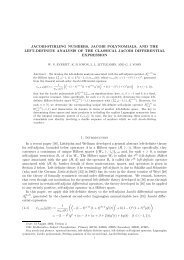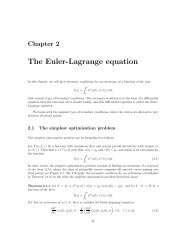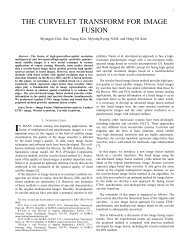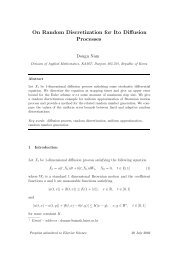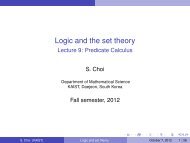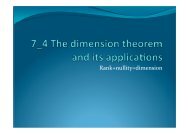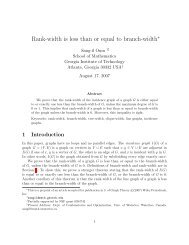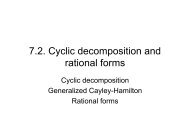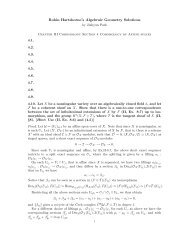Learning model structures based on marginal model structures of ...
Learning model structures based on marginal model structures of ...
Learning model structures based on marginal model structures of ...
You also want an ePaper? Increase the reach of your titles
YUMPU automatically turns print PDFs into web optimized ePapers that Google loves.
posed method <strong>of</strong> structural learning, we will assume that <strong>on</strong>ly the informati<strong>on</strong> which is embeddedin a given set <strong>of</strong> <strong>marginal</strong> <str<strong>on</strong>g>model</str<strong>on</strong>g> <str<strong>on</strong>g>structures</str<strong>on</strong>g> is available.This paper is organized in 7 secti<strong>on</strong>s. After introducing graphical terminologies and notati<strong>on</strong> insecti<strong>on</strong> 2, we derive a result which shows how two sets <strong>of</strong> graphs, where the graphs in <strong>on</strong>e set aresome type <strong>of</strong> subgraphs <strong>of</strong> the graphs in the other set, are related in stochastic c<strong>on</strong>text and introducea type <strong>of</strong> graph, called a combined <str<strong>on</strong>g>model</str<strong>on</strong>g> structure (CMS), with regard to the relati<strong>on</strong>ship <strong>of</strong> thetwo sets <strong>of</strong> graphs. In secti<strong>on</strong> 4, we c<strong>on</strong>sider some types <strong>of</strong> separators <strong>of</strong> undirected graphs, called aself-c<strong>on</strong>nected separator and a prime separator, and use them to further investigate the relati<strong>on</strong>shipbetween the two sets <strong>of</strong> graphs. We then c<strong>on</strong>sider the noti<strong>on</strong> <strong>of</strong> graphical compatibility (Dawid &Studeny, 1999) in secti<strong>on</strong> 5 as a necessary relati<strong>on</strong>ship between graphs and show existence <strong>of</strong> aCMS <strong>of</strong> set <strong>of</strong> graphs when the compatibility c<strong>on</strong>diti<strong>on</strong> is satisfied am<strong>on</strong>g the graphs. In secti<strong>on</strong>6, we propose a combinati<strong>on</strong> method <strong>of</strong> graphs as a way <strong>of</strong> informati<strong>on</strong> reuse from a given set <strong>of</strong><strong>marginal</strong> <str<strong>on</strong>g>model</str<strong>on</strong>g>s. Finally, in secti<strong>on</strong> 7, we close the paper with some discussi<strong>on</strong> and c<strong>on</strong>cludingremarks.2 NOTATION AND PRELIMINARIESWe will c<strong>on</strong>sider <strong>on</strong>ly undirected graphs in the paper. We denote a graph by G = (V, E), where Vis the set <strong>of</strong> the indexes <strong>of</strong> the variables involved in G and E is a collecti<strong>on</strong> <strong>of</strong> ordered pairs, eachpair representing that the nodes <strong>of</strong> the pair are c<strong>on</strong>nected by an edge. Since G is undirected, that(u, v) is in E is the same as that (v, u) is in E. If (u, v) ∈ E, we say that u is a neighbor node <strong>of</strong> oradjacent to v or vice versa. We say that a set <strong>of</strong> nodes <strong>of</strong> G forms a complete subgraph <strong>of</strong> G if everypair <strong>of</strong> nodes in the set is adjacent to each other. If every node in A is adjacent to all the nodes in B,we will say that A is adjacent to B. The set <strong>of</strong> all the neighbor nodes <strong>of</strong> a node v in G is denoted bybd G (v); if v becomes a set, A say, we define bd G (A) = ∪ v∈A bd G (v) \ A. We define the closure <strong>of</strong>a set A as cl G (A) = bd G (A) ∪ A. We denote by C(G) the set <strong>of</strong> cliques <strong>of</strong> G.A path <strong>of</strong> length n is a sequence <strong>of</strong> nodes u = v 0 , · · · , v n = v such that (v i , v i+1 ) ∈ E,i = 0, 1, · · · , n − 1 and u ≠ v. If u = v, the path is called an n-cycle. If u ≠ v and u and v arec<strong>on</strong>nected by a path, we write u ⇋ v. We define the c<strong>on</strong>nectivity comp<strong>on</strong>ent <strong>of</strong> u as[u] = {v ∈ V ; v ⇋ u} ∪ {u}.We say that a path, v 1 , · · · , v n , v 1 ≠ v n , is intersected by A if A∩{v 1 , · · · , v n } ̸= ∅ and neither<strong>of</strong> the end nodes <strong>of</strong> the path is in A. We say that nodes u and v are separated by A if all the pathsfrom u and v are intersected by A. In the same c<strong>on</strong>text, we say that, for three disjoint sets A, B,and C, A is separated from B by C if all the paths from A to B are intersected by C and write〈A|C|B〉 G . The complement <strong>of</strong> a set A is denoted by A c and the cardinality <strong>of</strong> a set A by |A|. Fortwo collecti<strong>on</strong> <strong>of</strong> sets, A and B, we write A ≼ B if, for every set a in A, there exists a set b in Bsuch that a ⊆ b.For A ⊂ V , we define an induced subgraph <strong>of</strong> G c<strong>on</strong>fined to A as GAind = (A, E ∩ (A × A)).We also define a graph, called a Markovian subgraph <strong>of</strong> G c<strong>on</strong>fined to A, which is formed fromby completing the boundaries in G <strong>of</strong> the c<strong>on</strong>nectivity comp<strong>on</strong>ents <strong>of</strong> the complement <strong>of</strong> Aand denote it by G A . If G ′ is a Markovian subgraph <strong>of</strong> G, we write G ′ ⊆ M G.If G = (V, E), G ′ = (V, E ′ ), and E ′ ⊆ E, then we say that G ′ is an edge-subgraph <strong>of</strong> G andwrite G ′ ⊆ e G. If G ′ is a subgraph <strong>of</strong> G, we call G a supergraph <strong>of</strong> G ′ . For a graph G, we will denotethe set <strong>of</strong> nodes <strong>of</strong> G by V (G).The cliques are elementary graphical comp<strong>on</strong>ents and so we will call the intersecti<strong>on</strong> <strong>of</strong> neighboringcliques a prime separator <strong>of</strong> the decomposable graph G. The prime separators in a decomposablegraph may be extended to separators <strong>of</strong> prime graphs in some graphs, where the prime graphsGAind3



